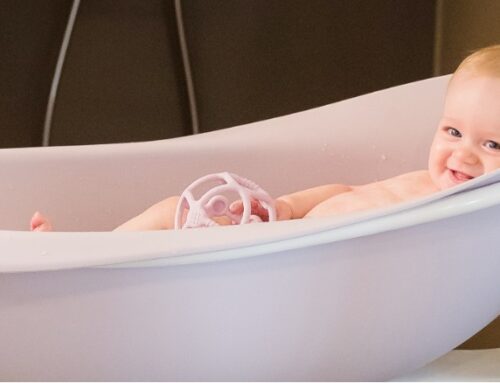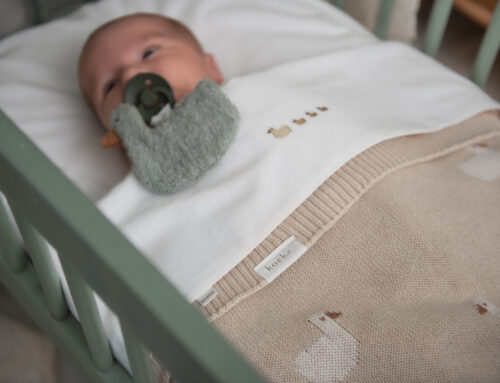What does the future bring us on the subject of feeding babies and children? The developments are coming fast, so let’s shine a light on products that are marketable or in their concept phase. One thing is for sure: nothing can replace the breastfeeding mother, but more and more products that approach this way of feeding very closely are arriving on the market.
We have noticed several important trends from all the innovations passing us by. Firstly: more and more breast pumps and bottle systems are aimed at helping mothers in breastfeeding for as long and as comfortable as possible. Secondly: mothers are under time pressure, so clever products are developed for limiting this pressure. Thirdly: more and more techniques are processed in products that can be connected to apps on smartphones and tablets. Fourthly: the role of durability in terms of material use and recycling is increasing more and more in product development. Let’s outline some innovations.
Borrn silicone baby bottle
Studio Blond in London designed a bottle with silicone interior: Borrn. With this, they claim to be the most hygienic bottle on the market. According to the developers, the content of the bottle never gets in touch with the plastic, but only touches high-grade BPA free silicones. The Borrn bottle has a double side, the plastic structure of the bottle is inside of the silicone side. This makes the sides of the bottle thicker than normal, but this also makes the bottle firm and the material is heat-resistant, so that sterilizing is not a problem. The bottle is also durable, because hardly any plastic is processed in it. Thanks to the oval shape, the bottle can easily be grabbed and it does not roll away. The bottle grows with the child and can be given on to other children. And if you want to throw the bottle away, Borrn requests you to send it to them, so they can recycle it. Blond also had the opinion that many bottles were looking much too stereotyped: pink designs for girls and blue frills for boys. While the parents are the ones who give the bottle-feeding. In order to break with this, the choice has been made to use gender neutral colours.
Like a mother’s breast
The Borrn bottle reminds us of the mimijumi bottle that was launched several years before. The bottle is designed in such a way that the appearance, soft material and the colour look like a mother’s breast. However, more improvements have come in the meantime. For the new Zerø.Zerø anti-colic bottles of Suavinex, the anatomy of the woman’s breast has been closely observed. The teat expands from the middle and the natural shape and length of the nipple are simulated as good as possible (read more about this further in this number).
Self-thinking bottle Bebo
Bebo is equipped with sensors that keep track of how much a child has drunk. This information is sent to the smartphone of the parent. It also is a self-cleaning bottle. The idea comes from a group of students for the Innovation In A Week Project of the Ministry of New Things in Eindhoven. The Bebo bottle runs on a battery so that the milk can be heated and given anywhere and at any desired moment. The founders of Bebo Company hoped to bring the bottle on the market, but it got stuck at the prototype phase.
Pump2baby LacTeck
Why do mothers first have to pump milk and only thereafter give the bottle? This question made a mother think of Pump2baby: a pump in which the milk can directly be given to the baby through a tube and teat. The benefit is that pumping and feeding can occur at the same time. This means time gain. When children are hungry, the feeding can start right away. Nutrients do not get lost. This also saves time otherwise put in washing bottles and teats. Besides time gain, this can be a solution for mothers when a baby is not willing or able to drink from the breast for whatever reason (by ‘Moedermelknetwerk’).
Handsfree pumping
We know the Difrax pump, with which mothers can pump handsfree, but the American label Willow goes one step further. Willow conducted a study and discovered that 89% of the women wants to pump handsfree and that 67% of the women prefers to not take off any clothing for it. The inspiration for Chief Technology Officer John Chang was his own wife. He developed two oval-shaped shelves with techniques that women can put under their bra. The willow pumps calmly and silently, it collects the mother milk in donut-shaped plastic bags that are hidden in the shelves. Through an app and Bluetooth, it can be registered how much milk is pumped and when this is done.
Elvie pump
The Elvie that was introduced on Kind + Jugend last year works according to the same principle. The English Elvie is an intelligent wearable breast pump with shelves that are specially designed to wear in a feeding bra. Elvie is light in weight, works almost silently and has no tubes or wires. It is a matter of properly putting the silicone parts on the breast after which the shelves can be clicked onto them. Elvie then proceeds in a different setting. When the bag is full, the pumping automatically stops. Elvie consists of five parts that can easily be cleansed. It is possible to see how much milk is pumped and when this is done through an app.
Annotation
The benefits of handsfree pumping are clear: no hoses and wires, mothers do not need to be half-naked when feeding and can perform contact-free pumping anywhere: on the train, in the car, on holiday, at work, and during meetings. In these systems it is important that the shield is put on the breast/areola in the right way and right angle, injuries may otherwise arise. This asks for exercising and this way of pumping will not suit every mother. Because there were still some user problems, Willow has now launched a 2.0 version with transparent parts, which allows mothers to see where to put the shelves and to see the milk flow.
Comfortable pumping
More brands are taking big steps in the context of comfortable pumping. For example Medela, who now bring a PersonalFit Flex technology after having conducted extensive research. Their new pumps Swing Flex and Swing Maxi Flex are equipped with oval-shaped shields that are opened wider than the standard shields. The result: more milk production, better emptying of the breasts and improved comfort (read more about this further in this number).
Complete systems
To help mothers pump for longer and to avoid valuable mother milk from getting lost, complete systems in which it is possible to directly pump into a feeding bag exist on the market. The little bag can then be stored. When it is time for the bottle, this bag is put in a bottle holder without having to pour anything over. Examples: Suavniex Zerø.Zerø and the Babymooc Twist.
Heer feeding bench
Although breastfeeding in public is accepted more and more, many mothers do prefer having some privacy. Mothers often have negative experiences when it comes to breastfeeding in public. This is because most public spaces are not really set up for mothers with small children, and when there are spaces, these are grubby, uncomfortable, and not inviting for feeding. Design agency 52hours in Prague devised a solution for this: the Heer feeding bench. The pink bench provides comfort and privacy when mothers want to feed their babies. The bench has a long shape with a big seating with rounded parts at the end. These parts fold around the upper part of the mother as if these are two wings, without isolating mother and child from the outer world. The seating can be turned, which allows mothers to determine in what direction they would like to sit. The baby can also be rocked back and forth in this. The rest of the bench offers enough space for others. The bench received the name ‘Heer’ as an answer on the question ‘Where can I breastfeed?’ ‘Here’ was the answer, which was degenerated to ‘Heer’, but it also refers to ‘Her space’.
Breastfeeding for fathers
For whoever did not know it yet: fathers are capable of breastfeeding. For her final study project, product designer Marie-Claire Springham devised a hormone kit which realises this. The kit contains a breast pump, a compression vest, and hormones that should stimulate the milk products. By also giving fathers the possibility to feed, she want to relieve some pressure from the feeding mothers. This also creates a better connection between father and child. If fathers have this desire, they do have to take a prenatal course and take medication. Fathers-to-be receive progestogen for nine months, which is a substance that is also in the mini pill and is appropriate for women who want to give breastfeeding. Progestogen is also used as anticonception. These hormones generate breast-formation in men, the fathers also receive domperidone six weeks prior to the birth. This medication was originally meant for improving the intestines, but has milk production as an extra effect. It is a substance that is sometimes prescribed to mothers when they produce too little milk.








